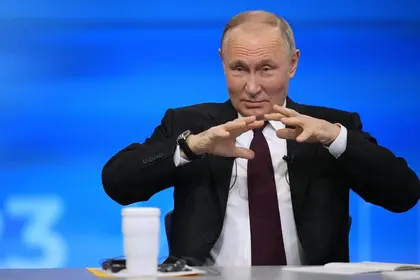During his annual address and press conference on Dec. 14, Russian President Vladimir Putin repeated many of the gimmicks of earlier years: he expressed concern about a host of local problems, promising to investigate new ways to assist citizens, and used the publicly televised forum to expound his foreign policy objectives in Ukraine.
Putin, acknowledging that Russia now has 612,000 troops in Ukraine, in contrast to the roughly 600,000 that President Volodymyr Zelensky said that the Ukrainian military has. When the full-scale invasion was launched, Russia was estimated to have roughly 150,000 troops in Ukraine.
JOIN US ON TELEGRAM
Follow our coverage of the war on the @Kyivpost_official.
Putin foreshadowed his future plans for Ukraine by referencing Odesa as a “Russian city,” explaining that his goals for Ukraine had not changed. In the lead-up to the full-scale invasion, Kremlin mouthpieces had often talked of the need to “liberate” Russian-speaking parts of the Ukraine.
Putin named “denazification,” “demilitarization," and Ukraine’s “neutral status” as his ongoing objectives in his “special military option.” He claimed that the invasion of Ukraine was nearly “a civil war,” as it was aimed at preventing the West from supposedly absorbing Ukraine into NATO and other schemes, tearing it away from its natural ally, Russia. Putin highlighted his point by referring to the current war as being like a war between “brothers.”

Moldova PM Says Russia Troops Must Leave Transnistria to Solve Crisis
The Russian leader’s repeated demand of Ukrainian neutrality, which would trigger Kyiv to forgo any future attempts to fulfill its’ people longtime objectives of joining NATO, coupled with the de-militarization of the besieged nation, would leave Ukraine defenseless against future Russian aggression. It would be a nearly impossible hard-sale to the Ukrainian public who would likely actively oppose both proposals.
Putin showed no signs of appreciating that Ukraine did not desire to be part of the Russian Federation, mocking the West for having decided to back Ukraine. He noted that the West was quickly running out of “freebies” for Ukraine and that the latter “produced almost nothing.”
Unlike Ukraine, which has struggled to find new recruits for the front, Putin claimed that Russia has plenty of new soldiers and so a second wave of mobilization would not be necessary. According to the Russian leader, 300,000 people were conscripted by the Russian Army and an additional 486,000 joined the Russian military on a contractual basis.
Russia, despite much larger numbers of soldiers than Ukraine, is thought to be suffering casualty rates significantly higher than that of Ukraine and has failed to make any significant gains in over half a year. Since the initial full-scale invasion in February 2022, Russia has continued to lose territory to the Armed Forces of Ukraine.
Putin, remarkably, referred to Ukraine’s efforts to win a way into Kherson and Dnipro as “a tragedy,” claiming Ukraine had lost some of its “best troops.” Putin, whose soldiers, under his command, were responsible for the deaths of some of Ukraine’s “best troops,” did not acknowledge the irony of his statement.
Moscow’s ban from participating in many international sports, including the 2024 Olympic Games in France, is something strongly supported by Kyiv. It clearly irks the Kremlin leader.
Putin argued that sports were meant to be outside of the realm of politics and to unite people, something that the International Olympic Committee (IOC) was ignoring and questioned the sense of Russia even sending athletes to participate under a white flag.
Putin’s annual press conference, holding much of the same, ritualized questions-and-answers pre-organized debate about Russia’s future as previous years, revealed little that keen Kremlin-watchers would have not known.
However, the one fact was again made abundantly clear: Putin is seeking the subjugation of Ukraine and has no plans of modifying this goal.
You can also highlight the text and press Ctrl + Enter










